

|
Wireless Communication: Contents |
 Recently the world has witnessed explosive
growth in the use of wireless communications. The number of wireless services
and subscribers has greatly expanded. Systems for mobile
analog and digital
cellular telephony, radio paging, and
cordless telephony have become commonplace.
Next generation systems will provide enhanced
communication services, such as data, electronic mail,
high resolution digital video or even full multimedia
communication. The development of such systems appeared a technical challenge,
with many issues still to be resolved.
Recently the world has witnessed explosive
growth in the use of wireless communications. The number of wireless services
and subscribers has greatly expanded. Systems for mobile
analog and digital
cellular telephony, radio paging, and
cordless telephony have become commonplace.
Next generation systems will provide enhanced
communication services, such as data, electronic mail,
high resolution digital video or even full multimedia
communication. The development of such systems appeared a technical challenge,
with many issues still to be resolved.
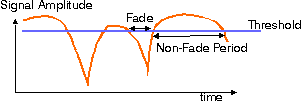
Figure: Sample of "fading" signal envelope
Channel impairments such as fading and multipath dispersion are described in terms of the Doppler spread, the time constants of fading, fade durations, level crossing rates, ( Rayleigh , Rician and Nakagami) amplitude probability densities and the coherence bandwidth. Radio propagation depends on the environment, so these parameters essentially differ for outdoor micro and macro cellular systems, indoor systems, short-range vehicle to vehicle systems.
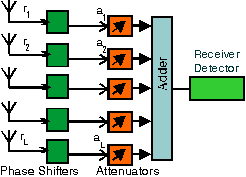 The developments in digital
micro-electronics and signal processing provided methods to overcome the anomalies
of the mobile channel, so these accelerated the growth of wireless
communication. One of the fundamental concepts to tackle the channel problems,
is diversity reception, which can substantially
improve the link performance. Moreover advanced digital modulation methods,
such as spread spectrum or MultiCarrier Modulation
(MCM) appear suitable for wireless communication.
The developments in digital
micro-electronics and signal processing provided methods to overcome the anomalies
of the mobile channel, so these accelerated the growth of wireless
communication. One of the fundamental concepts to tackle the channel problems,
is diversity reception, which can substantially
improve the link performance. Moreover advanced digital modulation methods,
such as spread spectrum or MultiCarrier Modulation
(MCM) appear suitable for wireless communication.
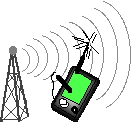
State-of-the-art signal processing can resolve most of the problems associated with the physical transmission over the unreliable wireless channel. Nowadays the main issues are the complexity of communication protocols that support full user mobility, including mobility across cells, networks or even across operators, the power consumption in the mobile or portable terminal, and the spectrum scarcity.
Due to spectrum scarcity, methods to efficiently share bandwidth among different users appeared of utmost importance. This implies the combined use of
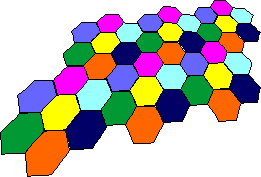
In the planning of cellular networks, operators employ computer methods to estimate the coverage and outage probability networks. Capacity enhancements are obtained through cell sectorization, reuse partitioning and dynamic channel allocation and statistical voice multiplexing ( DSI, which is for instance used in PRMA). Relevant performance criteria, such as subjective voice quality (signal outages and speech clipping), call blocking probability and lost call rates are applied to cellular networks.
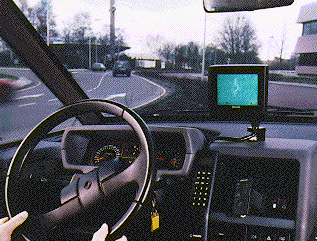 In future
wireless computer, multimedia networks or
communication networks for Intelligent Transport Systems
, the multiple access issue becomes substantially more important than it
is for circuit-switched voice communication. The ALOHA
, CSMA and ISMA protocols all
allow multiple users to share radio communication resources. How these
protocols perform differs substantially for guided (wired) and unguided
(radio) channels; performance is highly dependent on the physical
characteristics of the channel.
In future
wireless computer, multimedia networks or
communication networks for Intelligent Transport Systems
, the multiple access issue becomes substantially more important than it
is for circuit-switched voice communication. The ALOHA
, CSMA and ISMA protocols all
allow multiple users to share radio communication resources. How these
protocols perform differs substantially for guided (wired) and unguided
(radio) channels; performance is highly dependent on the physical
characteristics of the channel.
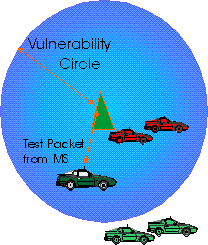 To attempt a realistic analysis of the
performance of wireless radio networks, the assumptions that a data packet is
always received successfully if no conflicting transmission (collision) occurs
simultaneously on the same channel and that data packets
involved in a collision are always lost,
must be refined. Moreover, the
performance seen by each participating terminal differs from the network
average performance and is highly dependent on the terminal's location. The
stability and delay depend on channel
characteristics.
To attempt a realistic analysis of the
performance of wireless radio networks, the assumptions that a data packet is
always received successfully if no conflicting transmission (collision) occurs
simultaneously on the same channel and that data packets
involved in a collision are always lost,
must be refined. Moreover, the
performance seen by each participating terminal differs from the network
average performance and is highly dependent on the terminal's location. The
stability and delay depend on channel
characteristics.
Specific solutions exist to efficiently resolve message collisions: these include the tree algorithm, the stack algorithm and dynamic frame length ALOHA. The combined use of CDMA and random access leads to interesting new system concepts.
In this CD ROM journal, you will find many aspects of wireless communications covered. For instance, wireless systems and standards are covered, such as GSM, DECT, AMPS, Cellular CDMA, Iridium, wireless LANs, Digital Audio and Video Broadcasting . It also provides a brief historical setting as well a discussion of the potential of various system concepts. The journal gives you an in-depth discussion of the technical issues, concepts and solutions behind these system standards. This includes the fundamentals of the radio propagation channel, digital and analog transmission, multiple access schemes, cellular reuse, etc. Bibliographic references on many topics are given.
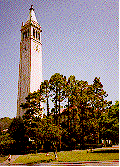
| The material presented here has originally been used for the 290i graduate course at the University of California at Berkeley. In 1994 and 1995 it was offered by the U.C. Berkeley Continuing Education in Engineering, University Extension program. Later, several other authors contributed to the extension of this material. | 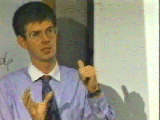
|

|
The conversion of the course material
into multimedia format is continuously under development. This is version 2, issued
in 1996. Questions, comments and suggestions for additional pages are welcome. Please use the email address
linnartz@eecs.berkeley.edu . Please refer to the WWW pages of the
publisher for more details about future
publications and updated editions.
|
You are invited to submit new contributions, which will be included in future versions. Submissions are subject to review, in which the reference and educational value of the proposed contribution will be an important criterion for publication. Click here for details.
You need a World Wide Web browser to access the material, but an on-line internet connection is not necessary. To fully enjoy this material, your browser should be able to access audio, view acrobat text and show video. An Adobe Acrobat ® reader is included.
Click here for further instructions and set-up.
This journal is written in hypertext. There is not an intended sequential
order of going through the material. However, the table
of contents may suggest a way of sequentially scanning the contents.
Moreover, at the end of each page, you'll find the following suggestions for
further browsing: